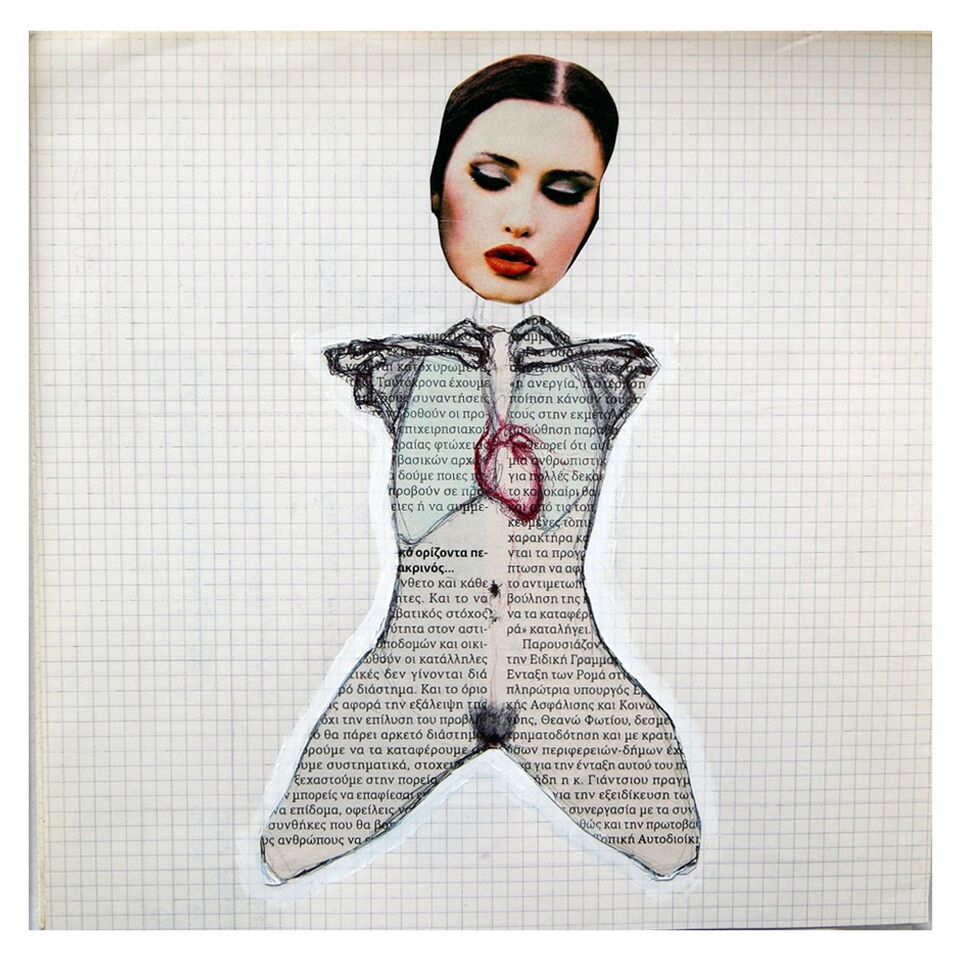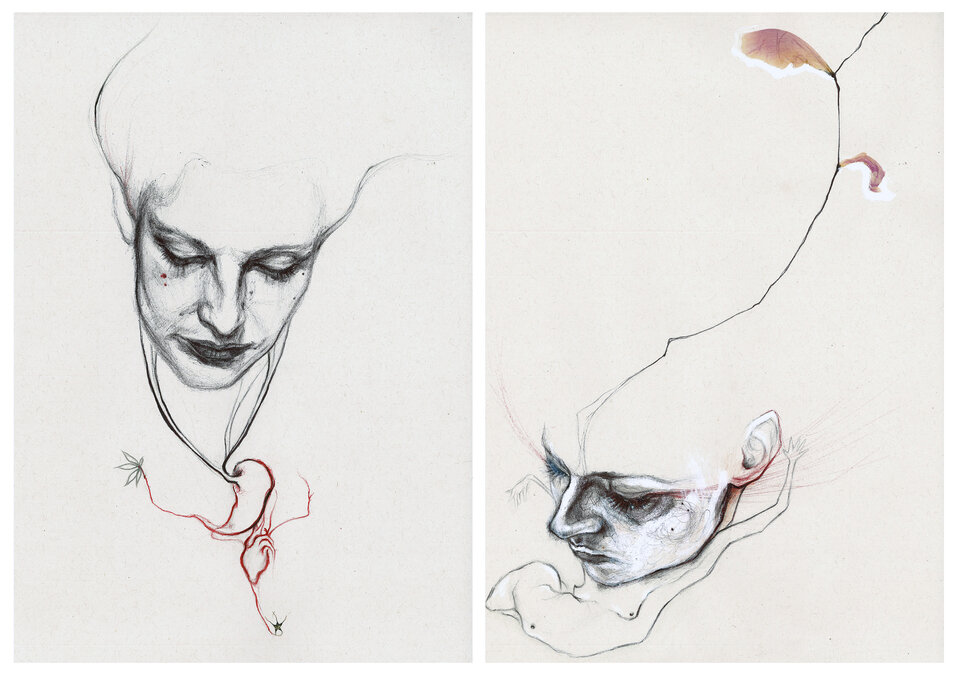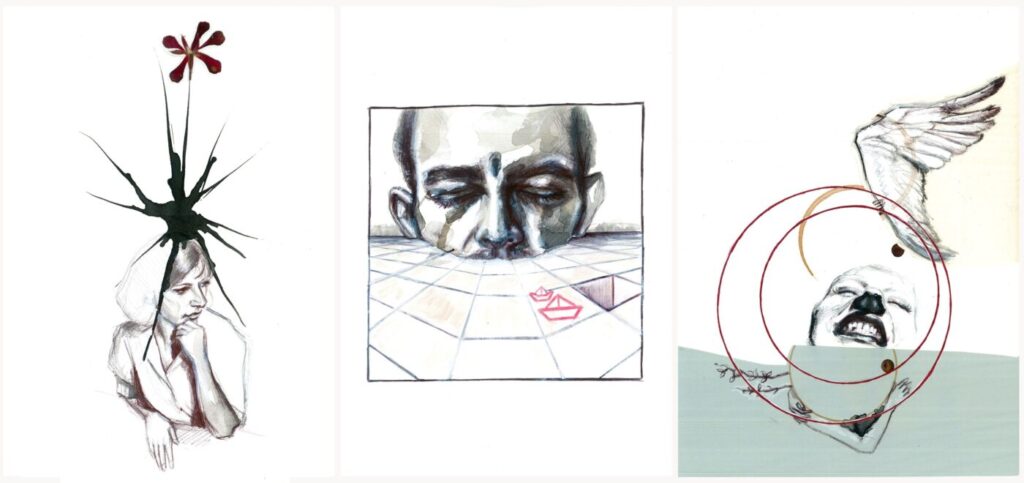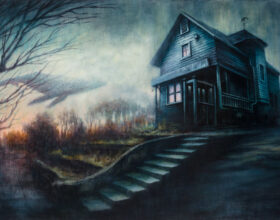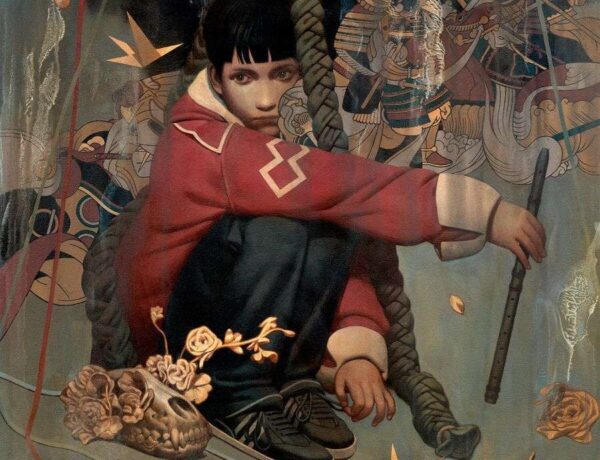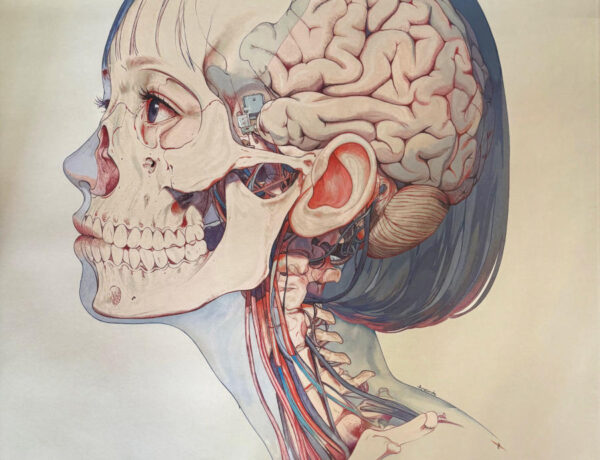Art is no puzzle to solve. Putting words on an artist’s works often leads to a reassuring (over)interpretation of what the artist might have wanted to say. And yet we might have missed the point: art is a plain call to delve inside, shutting our little voice and connecting with our inner worlds, an enticement to feel. Because our imaginaries feed from everything we experience and stems from both unconscious and conscious thoughts, feelings, dreams, memories, an artist’s life is often the best gateway to grasp his work and the inspiration underneath. Maria’s Maquieira fine, poetic drawings are a crafty combination of her roman cultural background, her love for poetry and nature, and her inextinguishable thirst for life and the experiences it offers.
Drawing from and playing with all types of arts – books, dance, films, books, etc., the 39-year-old Spanish artist always tries to keep flowing through her life and experiences, and extracting, materializing, sculpting her emotions along the way, like raw hidden gems she has to refine as a fuel to renewed creativity. Her most unique trait? She’s always preparing new experiments, concocting new forms, tests, projects in her small workshop in Galicia (Spain), Celtic lands of witches. Whether using dreams or her daily life, Maria Maquieira always digs for emotions with the mindfulness of a child, 100% present in the here and now.
Art is the space in which I feel united with others, with myself and with the world… so it is my way of being in life; in addition to my affections, it is my daily drive.
Interview with Maria Maquieira
When did you decide to call yourself an artist? Why did you become an artist?
I’ve always loved drawing. I got hooked to it as a child when I realised that it was an infinite world: a place where if you connected with your imagination, there was no end to it, there were always new things to explore and create. Soon I became interested in writing and music and as soon as I had to choose what to study, as a teenager, I opted for artistic training; so dedicating myself professionally to art has been something that has arisen naturally out of a restlessness and vital necessity. Art is the space in which I feel united with others, with myself and with the world… so it is my way of being in life; in addition to my affections, it is my daily drive.
You often make hints and references to your father in your works. How did your relationship with your parents impact your choice to become an artist?
My parents always respected and spurred my artistic interests, so my wish to dedicate myself to art was not a problem at all. My mother is a key figure, who understood my calling from very early on and didn’t hesitate to empower it and give me wings and the same unwavering support that she still gives me today. She has always pushed me to do what would make me happiest and not to be afraid, which is very important when it comes to knowing how to live a career as challenging as ours.
My father was a poet and a writer, a man who led an unusual and utopian life, so from his side also I grew an interest in culture and became familiar with the idea of letting ourselves being led by what we believe in. My father’s poetry is essential, naked, raw, unadorned and, at the same time, full of beauty and grace. He connected to the essence and the heart of life and death, of the emotions, questions and longings of the human being. He handed down to me this interest for what is pure and universal. Both my mother and my father are great teachers to me.
I think the emotion that most motivates me to create is desire: the desire to learn, the desire to communicate, to express, to connect, to realise oneself and as I mentioned before, to transform.
Art schools are unique opportunities to develop one’s craft and learn precious art knowledge. Yet, many artists learnt few of the required skills to thrive professionally. What did you learn from your school years?
My higher education started initially with Art History and ended with Fine Arts, both in Spain and Italy. I find infinite answers in art history to understand the creative process and to learn how to face life challenges. I have learnt from it that nothing comes from nothing, on the contrary : artists pass down to each other a gigantic conscious and unconscious legacy. Art History also taught me a deep respect for my craft. Regarding the Fine Arts, I was trained in various centres depending on what was the requirement or the interest that I wanted to resolve at the time, which was thus linked to a fairly self-taught and personal process – I started in Spain, then I move to the Free Academy of Fine Arts in Rome, later on in Poland. I learnt to value what I wanted to say as an artist, to look what I could bring as a contribution, regardless of the prevailing codes of the moment, and to let myself being led by my own artistic interests.
What do you think of today’s academic schools?
Fortunately, there are a lot of them and with that a lot of possibilities to choose from. There are some with really interesting and growing multidisciplinary programmes. I imagine that the most important thing is to find the one that suits you and also to have the courage to quit an academy if you feel that the teaching line doesn’t fit your personal goals.
As an artist, what drives you to create and fuels your creativity?
I think the emotion that most motivates me to create is desire: the desire to learn, the desire to communicate, to express, to connect, to realise oneself and as I mentioned before, to transform. The truth is that it all starts from a very magical impulse that is simply unavoidable. It also has to do with what I explained previously, the special sensation that one feels when one sees his or her own ideas materialised. If you stop to think about it, it is a wonderful act; we are able to produce things that did not exist before. It is a way of giving life and form to our thoughts, emotions, longings, also to our fears and anxieties, thus obtaining a new way of relating to it all.
Creating is a powerful gateway to understanding finer layers of our own realities. What is your own vision of creating art?
I believe that art creation transforms as well as it clarifies, it brings light on things, literally elucidates them. Like other practices such as philosophy, it makes us constantly think about who we are individually and collectively, about where we stand regarding what happened to us and what is happens in the context and in the world around us. Creating grants us codes of understanding, analysis and evolution, as well as codes of communication. At the same time, it helps us to see and observe things in a different way. This makes me realize that everything is changing all the time, allowing me to let myself being led by this process and helping me to discover and connect to great universal places, therefore shelters, that unite us as a species.
Beauty is a need, a quest. Beauty heals.
Do you have a specific creative process?
In all these years of work, I’ve learned that it doesn’t benefit me to have a routine because it doesn’t belong to me. Developing several projects at the same time allows me to be much more creative because they feed each other, so I work every day a lot, but each process is different. One of my main objectives is to evolve… to improve, so I feel that I am constantly learning and to do so, I try to include self-commitment, my demands with my work, play and experimentation in my artistic path.
How would you define your imaginary worlds?
Constantly boiling, wanting to express themselves, to take shape. Always very active and open to be contaminated and to dialogue with the infinity and richness of other worlds, languages, fantasies, imaginary worlds.
The creative process is very lonesome. One finds oneself constantly making decisions with nobody but oneself, so intuition, which in the end is also based both on our unconscious and on all the latent learnings that we store inside, is a great ally.
When I first met your works, I couldn’t help myself enjoying the refinement of your female portraits, recalling modern versions of Renaissance’s deities. A sacred beauty is infusing through all your works. What is beauty for you? the Sacred?
Beauty is a need, a quest. Beauty heals. Finding it in the moments of greatest difficulty and shadow, in which it is also present (in a grief, in a crisis, in pain) is one of our greatest challenges. But it is also a balm to transcend and transform any circumstance. Art is a very powerful tool for this. Beauty helps us to exist. I would define the sacred as everything that connects us with the sublime and the ineffable in the universe. Everything that makes us aware of our connection to an immense whole that is at the same time within us. Again art is an extraordinary way to be aware of this.
What also struck me was the fluidness of your flowing compositions, dreamscapes. What place does intuition or dreams have in your creations?
The creative process is very lonesome. One finds oneself constantly making decisions with nobody but oneself, so intuition, which in the end is also based both on our unconscious and on all the latent learnings that we store inside, is a great ally. I take it very much into account. As for dreams, I have been studying and writing my dream world for years. I have a strong dialogue with them!
How do you get the ideas for your creations?
Through many ways. As the writer Stefan Zweig said, “I think that the creative process is one of the deepest mysteries, but within what I manage to identify or verbalize, I could tell you that ideas manifest themselves both through a more mental, reflective process on some cases and through a more magical, oneiric way, in which they simply arise.” It’s like a duality or a dance that feeds back and where, depending on the moment, one source has more weight than the other.
How do you incorporate your ordinary life, your experiences into your work?
We are porous to what happens to us, so unconsciously or consciously, everything we experience every day is reflected in one way or another in what we do. Our optimism, pessimism or position on the status quo, our material situation, life experiences or our state of mind are reflected or filtered in everything we express in some way or another, whether we want it or not. There are projects in which I explicitly start from intimate or personal aspects of me, in others I don’t and I give more weight to external references. But in all of them, whether they are more or less self-referential, I try to transcend what is individual and move towards what is universal and collective.
Any words to young artists willing to take the plunge?
I would tell them that they are about to start on a path that is a challenge in itself, but so beautiful, transformative and unique at the same time that it all pays off. I would also tell them to believe in hard work and perseverance and that their passion for what they do will be the best engine to defend and develop their work with strength.)
I am fascinated by the human being and our history as a species. That’s where I find everything.
What are your best, most unpleasant memories and experiences of your life as an artist?
Most of my experiences throughout my artistic journey are very positive. The constant learning, the transformation on a human level that I was talking about in previous lines, the colleagues and people I have collaborated and met, the great emotion that is experienced when the public connects with what we do and therefore we manage to establish that beautiful bond of communication, the incredible satisfaction that is produced when we achieve works that initially were only in our head or inside. The most difficult thing is perhaps dealing with uncertainty, but even so, this is part of the exciting process and the learning path.
What projects do you have at the moment? Some that you love very much?
I’m currently very motivated by a project called “Dream and Revolution”, based on the latest book by the philosopher Carolina Meloni, who has studied the effects that the lockdown and the health and social crisis we are living through have had on our dream world. We will make a travelling exhibition in Spain (it will be shown in Galicia, Madrid and La Casa Amarilla in Malaga) with the artistic results, on which I am currently working. At Annanià Films, the small film production company of which I am a member, we are in the post-production phase of a short film in which my drawings are the protagonists of a very magical plot. I am also immersed in several illustration projects such as the one I am developing for the next book created hand in hand between the musician Artabe and the poet Juanlu Mora, preparing upcoming dates of drawing and live music with the band Two Faces; and as an art historian, writing an article for Vertigo Magazine about the concept of freedom in art.
Current sources of inspiration? Artists you admire?
I am fascinated by the human being and our history as a species. That’s where I find everything. I dive through anthropology, history, psychiatry, philosophy and any of our artistic manifestations (poetry, dance, theatre, opera). Some concrete examples of contemporary artists I admire: Bill Viola, Fernando de France, Gonzalo Borondo, Silvia Perez Cruz, Paula Rego, Yoan Bourgeois.


